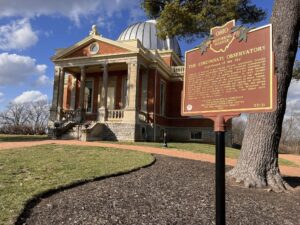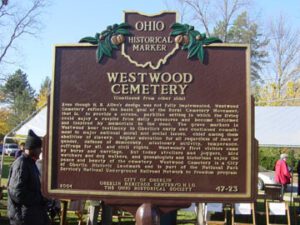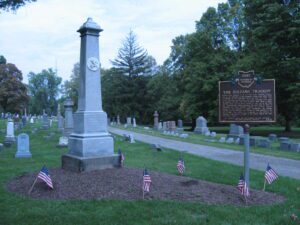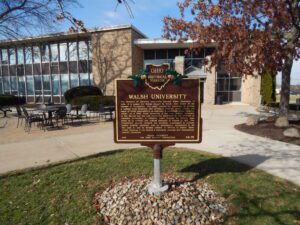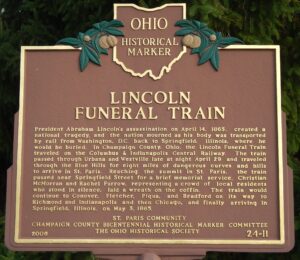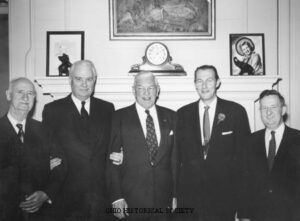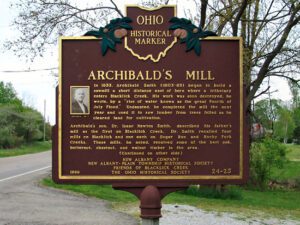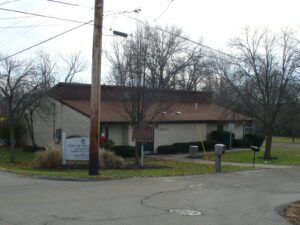, OH
Prompted by response to his popular lectures, astronomer Ormsby MacKnight Mitchel (1809-1862) founded the Cincinnati Astronomical Society (CAS) in 1842. With CAS funding, Mitchel traveled to Munich, Bavaria, to acquire the optical elements for what became the world’s second largest refractor telescope. In 1843 former president John Quincy Adams laid the cornerstone of the observatory building, located upon the hill since known as Mount Adams. The Cincinnati Observatory was completed and opened for study in 1845. Mitchel, who died in service during the Civil War, was among the first to popularize astronomy in America. The telescope he brought to Cincinnati remains in daily use, the oldest such instrument in the United States.
, OH
Shortly after Oberlin Colony was established in 1833, a two-acre burying ground was set aside south of Plum Creek in the area bounded by Main, Morgan, and Professor streets. By 1861, however, with the town and Oberlin College growing and the Civil War escalating, the need for a larger cemetery became clear. After an extensive search, 27.5 acres of land belonging to Henry Safford were acquired one mile west of the center of Oberlin. H.B. Allen was hired to create a design in the style of the Rural Cemetery Movement, and in July 1864 Westwood Cemetery was formally dedicated. Burials in Westwood had actually begun in August 1863, and over the next few years hundreds of remains were reinterred from Oberlin’s “Old Cemetery” and from burying grounds in surrounding communities. In the mid-1860s the cemetery was enlarged to its present 47 acres, and in 2004 burials and memorials were estimated to number almost ten thousand. (Continued on other side)
, OH
Soldiers from Company F of the 115th Ohio Volunteer Infantry died in the explosion of the steamboat Sultana seven miles north of Memphis on the Mississippi River on April 27, 1865. The Sultana reportedly carried more than 2,400 passengers–six times its capacity of 376. The vast majority were Union soldiers recently freed from Southern prisons at the end of the Civil War. Approximately 1,800 passengers and crew died in what is considered the worst maritime disaster in American history. Company F was organized in Stark, Columbiana, and Portage Counties and was mustered into service at Camp Massillon in the fall of 1862. This marker is a memorial to the soldiers of Company F who died as a result of the Sultana tragedy and other war-related causes.
, OH
The Brothers of Christian Instruction founded Walsh University in 1958. It is named for Bishop Emmett M. Walsh, then leader of the Diocese of Youngstown. The order created the institution to provide a college-level education that developed students’ moral virtues and sense of social responsibility as embodied in traditional Judeo-Christian values. As of 2015, Walsh University is the only Catholic university in the diocese and the only university sponsored by the Brothers of Christian Instruction, a religious order founded by the Fathers Jean Marie de la Mennais and Gabriel Deshayes in France in 1819. The University’s mission reflects the Brothers’ commitment to provide quality Catholic education with an international perspective to all who seek it, and to develop leaders in service to others. Since Walsh’s founding, it has become a successful regional and international Catholic university.
, OH
President Abraham Lincoln’s assassination on April 14, 1865, created a national tragedy, and the nation mourned as his body was transported by rail from Washington D.C. back to Springfield, Illinois, where he would be buried. In Champaign County, Ohio, the train passed through Urbana and Westville late at night April 29 and traveled through the Blue Hills for eight miles of dangerous curves and hills to arrive in St. Paris. Reaching the summit in St. Paris, the train paused near Springfield Street for a brief memorial service. Christian McMorran and Rachel Furrow, representing a crowd of local residents who stood in silence, laid a wreath on the coffin. The train would continue to Conover, Fletcher, Piqua, and Bradford on its way to Richmond and Indianapolis and then Chicago, finally arriving in Springfield, Illinois, on May 3, 1865.
, OH
Ohio’s fifty-ninth governor, Marietta native C. William O’Neill was the only Ohioan to head all three branches of state government. An honor graduate of both Marietta High School and Marietta College, O’Neill won election to the Ohio House of Representatives in 1938, serving there until 1950 but interrupted from 1943-1946 when he was with General George Patton’s Third Army in Europe during World War II. In 1947 he became the youngest Speaker of the House in Ohio history. Elected Attorney General in 1950, he won the governorship in 1956, modernizing the highway and mental health departments during his tenure. His election to the State Supreme Court in 1960 and elevation to Chief Justice in 1970, noted by landmark judicial reforms, capped his exemplary career of public service to Ohio.
, OH
In 1833, Archibald Smith (1803-83) began to build a sawmill a short distance east of here where a tributary enters Blacklick Creek. His work was soon destroyed, he wrote, by a “rise of water known as the great Fourth of July Flood.” Undaunted, he completed the mill the next year and used it to saw lumber from trees felled as he cleared land for cultivation. Archibald’s son, Dr. Isaac Newton Smith, described his father’s mill as the first on Blacklick Creek. Dr. Smith recalled four mills on Blacklick and one each on Sugar Run and Rocky Fork Creeks. These mills, he noted, received some of the best oak, butternut, chestnut, and walnut timber in the area. (Continued on other side)
, OH
Civic organizations played pivotal roles in the development of the residential community of Hazelwood, founded as a subdivision of Blue Ash in 1888. The Hazelwood Civic Association, initially established as the Brothers Civic Society in 1941, addressed community needs by working for public improvements and promoting civic relations through social events and educational programs. Efforts by the HCA led to the construction of a new civic center and the introduction of the Boy and Girl Scouts and other programs that were previously unavailable to African-American children. Hazelwood’s deterioration and the threat of encroaching industrial development led to the formation of the Hazelwood Improvement Corporation in 1968. The HIC, acting as an agent of the city of Blue Ash, helped to upgrade housing, pave roads, build new homes to ensure a residential nature, install water and sewage systems, and erect streetlights. In 1997, the Hazelwood Community Association was organized to assist residents during Hazelwood’s transition to a racially integrated community.


